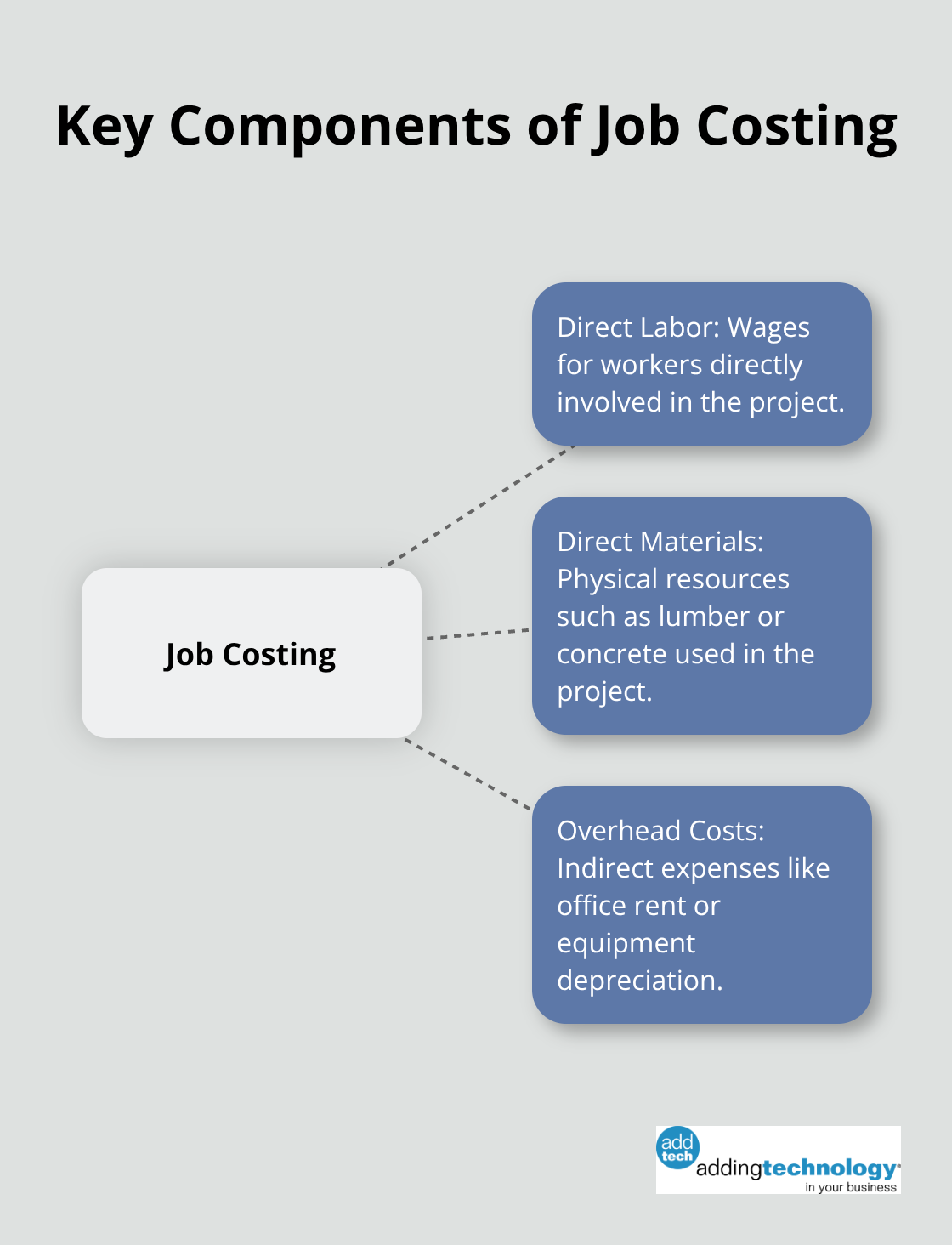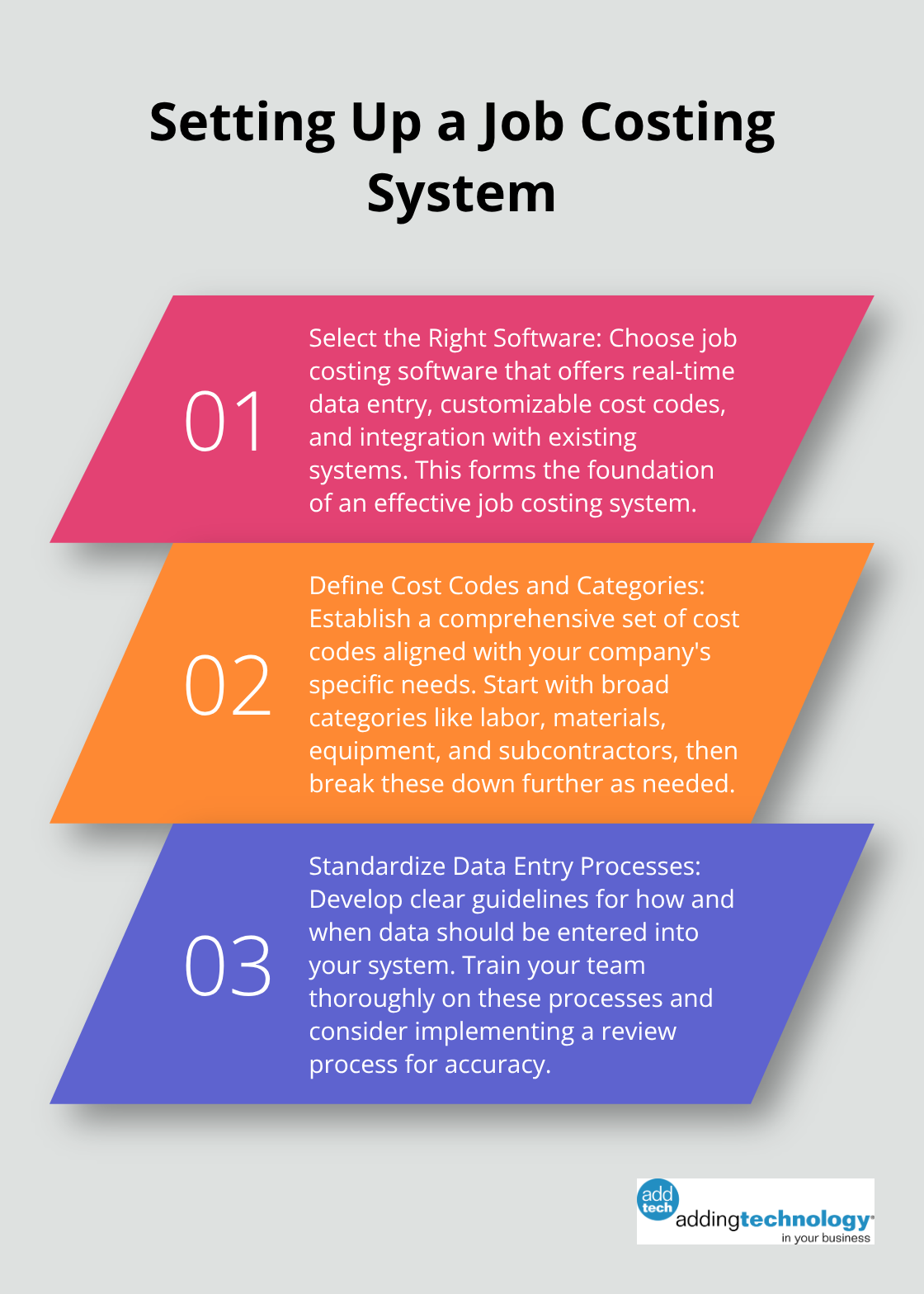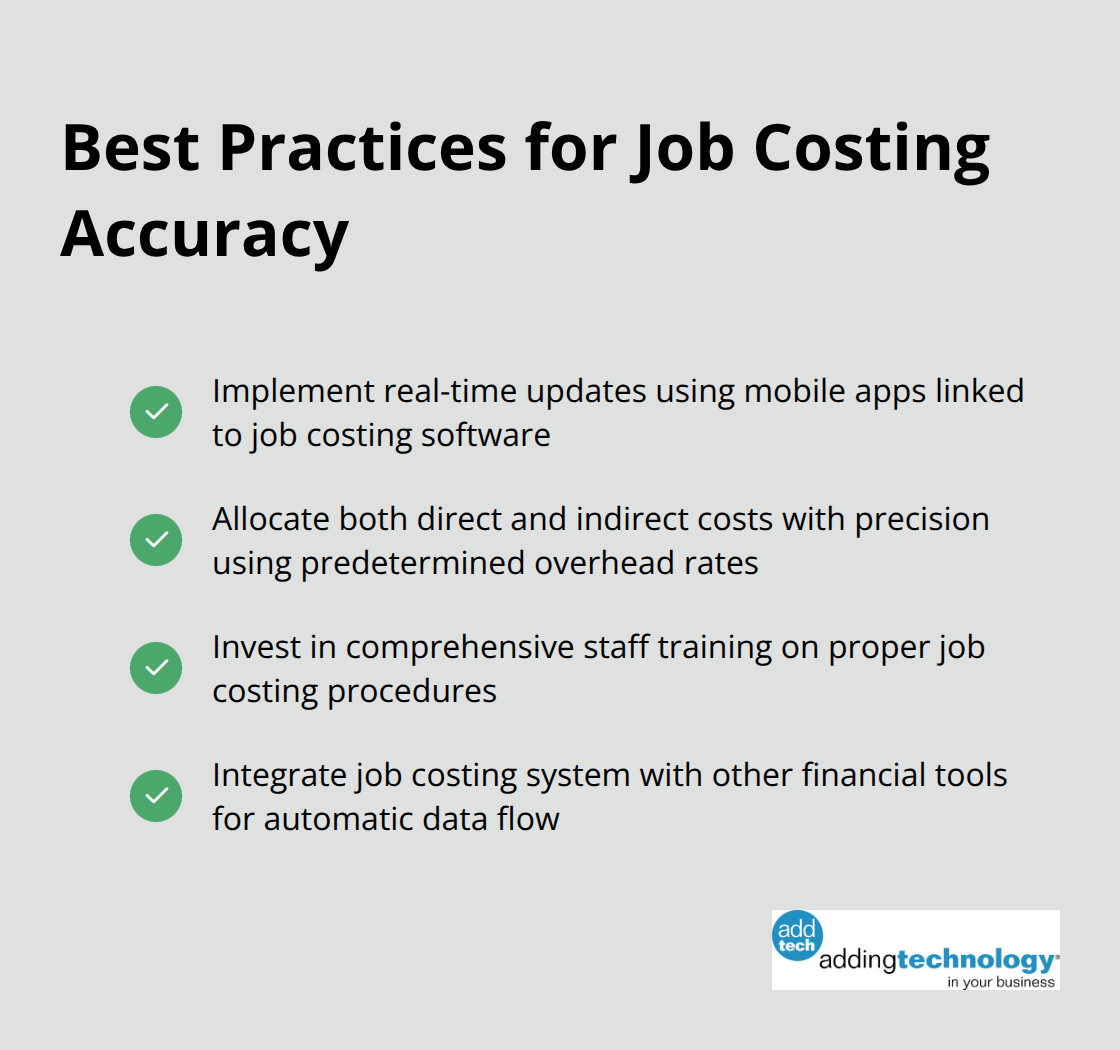
At adding technology, we understand the critical role of job costing in construction projects. An effective job costing system can make or break a company’s profitability and project management efficiency.
In this post, we’ll guide you through implementing a robust job costing system, providing practical examples and best practices. Whether you’re looking to refine your existing process or build one from scratch, our insights will help you achieve more accurate cost tracking and improved financial control.
Job costing in construction forms the backbone of financial management for projects. At Adding Technology, we witness the importance of this process for construction companies across the spectrum. It transcends mere expense tracking; it involves a detailed understanding of cost allocation for each project.
A robust job costing system comprises three main elements: direct labor, direct materials, and overhead costs. Direct labor encompasses wages for workers directly involved in the project. Direct materials include physical resources (such as lumber or concrete). Overhead costs cover indirect expenses (like office rent or equipment depreciation).

To implement this system effectively, construction companies need a powerful mechanism to capture and categorize these costs accurately. Specialized software plays a pivotal role here. Many industry experts believe that computer technology is and will be one of the most important means for improving construction industry cost effectiveness.
Real-time tracking represents a significant leap forward in job costing. The era of monthly financial reviews has ended. Job costing allows construction businesses to accurately record all expenses associated with a job, in real-time, with a true representation of the entire project’s costs.
Accurate job costing influences not only current projects but shapes the entire business strategy. Precise cost knowledge for each project aspect allows for more competitive bidding on future jobs. It also helps identify the most profitable project types for your company.
To maximize job costing benefits, integration with other financial systems is essential. This integration provides a comprehensive view of your company’s financial health. For instance, connecting job costing data with the general ledger can reveal trends and inform resource allocation decisions.
The implementation of an effective job costing system requires ongoing attention and refinement. With the right tools and approach, it can revolutionize your construction business, offering the financial clarity and control needed to excel in a competitive industry. The next section will explore the practical steps to set up a job costing system tailored to your construction business needs.
The foundation of an effective job costing system is robust software. Spreadsheets might suffice for small operations, but they quickly become unwieldy as your business grows. We recommend job costing software that tracks real costs in real time, allowing you to protect your margins before the project is over.
Look for software that offers real-time data entry, customizable cost codes, and integration with your existing systems.
After you choose your software, establish a comprehensive set of cost codes. These codes should align with your company’s specific needs and the types of projects you typically undertake.
Start by categorizing costs into broad groups such as labor, materials, equipment, and subcontractors. Then, break these down further. For example, labor might be divided into skilled and unskilled workers, or by trade (electricians, plumbers, etc.).
The Construction Specifications Institute’s MasterFormat provides a standard for organizing construction information into a logical and consistent format. It helps architects, engineers, and contractors to streamline their processes. However, don’t hesitate to customize this to fit your specific needs.

Consistency is key in job costing. Develop clear guidelines for how and when data should be entered into your system. This might include daily time entry for labor, immediate recording of material purchases, and weekly updates on equipment usage.
Train your team thoroughly on these processes. Consider implementing a review process where entries are checked for accuracy before being finalized. This extra step can save countless hours of troubleshooting down the line.
Setting up a job costing system is not a one-time event. It requires continuous refinement and adaptation as your business evolves. Regular reviews of your system’s effectiveness can help identify areas for improvement and ensure you’re getting the most out of your job costing efforts.
With a solid job costing system in place, you’re well-positioned to implement best practices that will further enhance your financial management. Let’s explore these practices in the next section.
At Adding Technology, we recognize the power of up-to-the-minute cost tracking. Modern construction demands instant data. Equip your field workers with mobile apps linked to your job costing software. This allows them to input labor hours and material usage directly from the job site.
The Construction Industry Institute provides members with access to original research, resources, and opportunities to help businesses and people thrive. This level of precision empowers project managers to make swift, informed decisions (potentially saving thousands of dollars on each project).
Understanding true project profitability requires accurate allocation of both direct and indirect costs. While direct costs are straightforward, indirect costs need careful consideration. We recommend a systematic approach to allocating overhead costs to each project.
Try this method: Use a predetermined overhead rate based on direct labor hours. This involves adding up your estimated overhead costs, picking your allocation base, estimating your allocation base, and then doing the math.

Your job costing system’s effectiveness depends on the people using it. Dedicate time to train your staff on proper procedures. This includes accounting personnel, project managers, foremen, and field workers who input data.
Create detailed documentation and conduct regular training sessions. A buddy system where experienced staff members mentor newcomers can reduce errors and ensure consistent data entry across all projects.
Job costing is part of your broader financial ecosystem. Integrate your job costing system with other financial tools like your general ledger, accounts payable, and payroll systems.
This integration allows for automatic data flow, reducing manual entry errors and providing a comprehensive view of your financial health. For instance, when a material invoice enters accounts payable, it should automatically update the relevant job cost. This level of integration can save hours of manual reconciliation and provide real-time project profitability insights.
An effective job costing system transforms construction companies. It provides deep insights into project profitability, enables competitive bidding, and identifies cost reduction opportunities. A practical example of a job costing system includes real-time labor tracking via mobile apps, automated material cost updates from supplier invoices, and predetermined overhead rates for accurate indirect cost allocation.
We at Adding Technology understand the challenges of implementing and maintaining an effective job costing system. Our expert accounting services are tailored for the construction industry, helping you streamline financial processes. We can help you build a solid financial foundation for your construction business through our structured approach and advanced technology integration.
Effective job costing is not just about tracking numbers; it informs decisions, improves efficiency, and drives profitability. The right tools and expertise set your construction company up for long-term success in a competitive industry. Take the next step towards financial clarity and control by exploring how our services can support your job costing needs.









At adding technology, we know you want to focus on what you do best as a contractor. In order to do that, you need a proactive back office crew who has financial expertise in your industry.
The problem is that managing and understanding key financial compliance details for your business is a distraction when you want to spend your time focused on building your business (and our collective future).
We understand that there is an art to what contractors do, and financial worries can disrupt the creative process and quality of work. We know that many contractors struggle with messy books, lack of realtime financial visibility, and the stress of compliance issues. These challenges can lead to frustration, overwhelm, and fear that distracts from their core business.
That's where we come in. We're not just accountants; we're part of your crew. We renovate your books, implement cutting-edge technology, and provide you with the real-time job costing and financial insights you need to make informed decisions. Our services are designed to give you peace of mind, allowing you to focus on what you do best - creating and building.
Here’s how we do it:
Schedule a conversation today, and in the meantime, download the Contractor’s Blueprint for Financial Success: A Step by-Step Guide to Maximizing Profits in Construction.” So you can stop worrying about accounting, technology, and compliance details and be free to hammer out success in the field.